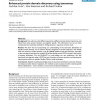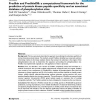159 search results - page 7 / 32 » Comparing approaches to predict transmembrane domains in pro... |
BMCBI
2007
13 years 8 months ago
2007
Background: Knowing the subcellular location of proteins provides clues to their function as well as the interconnectivity of biological processes. Dozens of tools are available f...
BMCBI
2007
13 years 8 months ago
2007
Background: Protein motions play an essential role in catalysis and protein-ligand interactions, but are difficult to observe directly. A substantial fraction of protein motions i...
BMCBI
2007
2007
Application of amino acid occurrence for discriminating different folding types of globular proteins
13 years 8 months ago
Background: Predicting the three-dimensional structure of a protein from its amino acid sequence is a long-standing goal in computational/molecular biology. The discrimination of ...
BMCBI
2004
13 years 7 months ago
2004
Background: It is well known that different species have different protein domain repertoires, and indeed that some protein domains are kingdom specific. This information has not ...
BMCBI
2008
13 years 8 months ago
2008
Background: We have previously described an approach to predicting the substrate specificity of serine-threonine protein kinases. The method, named Predikin, identifies key conser...


